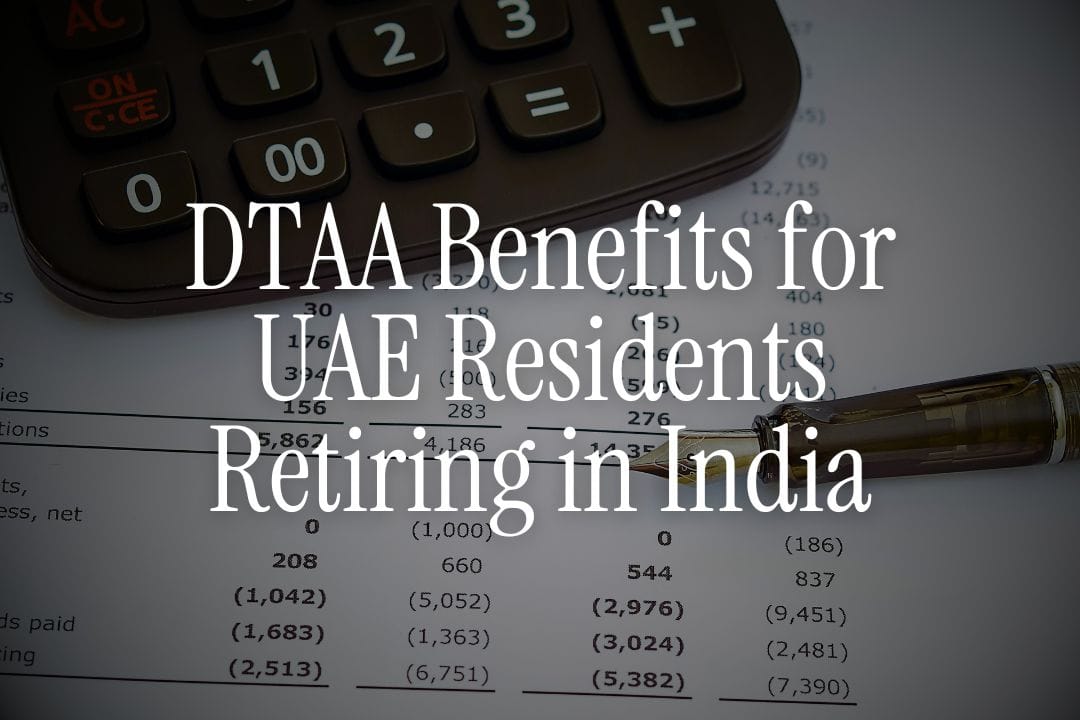
You've spent 20+ years building wealth in Dubai. Zero income tax. Great savings. Now you're planning to return to India for retirement.
Then reality hits: India will tax your global income once you become a resident. Your ₹80 lakh in Indian fixed deposits? 30% tax on interest. Your rental property in Pune? 30% tax. Your mutual fund gains? More tax.
Wait-does this mean you'll lose 30-40% of your retirement income to Indian taxes?
Not if you understand the India-UAE Double Taxation Avoidance Agreement (DTAA).
At Belong, we've helped over 8,000 NRIs navigate cross-border taxation, and UAE residents have one of the most advantageous positions globally. The combination of UAE's zero personal income tax and the India-UAE DTAA creates unique opportunities that can save you ₹2-5 lakh annually-sometimes more.
This isn't theoretical. Last month, a member of our WhatsApp community shared how proper DTAA planning reduced his Indian tax bill from ₹3.2 lakh to ₹97,000-a 70% reduction.
This guide covers everything you need to know about leveraging the India-UAE DTAA for your retirement, including the landmark 2024 ruling that could eliminate taxes on your mutual fund gains entirely.
Why UAE Residents Have a Golden Opportunity
Let's start with what makes your situation unique.
Most NRIs face double taxation-paying taxes in both their resident country (where they live) and source country (where income originates). For example, a US resident with Indian rental income pays US income tax (up to 37%) plus Indian tax (up to 30%), then claims credits to offset.
You don't have that problem.
The UAE has zero personal income tax. No tax on salary. No tax on investment income. Nothing.
This means when you earn income from India, you're only dealing with Indian taxes-but even those can be dramatically reduced or eliminated using the India-UAE DTAA signed in 1993 and last revised in 2007.
Here's what this means in practice:
Scenario 1: Interest on NRO Fixed Deposits
- Without DTAA: 30% TDS (₹3 lakh on ₹10 lakh FD at 10%)
- With DTAA: 12.5% TDS (₹1.25 lakh)
- Your savings: ₹1.75 lakh annually
Scenario 2: Private Pension from Indian Employer
- Without DTAA: Fully taxable at slab rates (up to 30%)
- With DTAA (Article 19): Zero tax if you're a UAE resident
- Your savings: Potentially ₹2-5 lakh+ annually
Scenario 3: Capital Gains on Mutual Funds
- Without DTAA: 12.5% tax on long-term capital gains and 20% on short-term capital gains on mutual funds
- With DTAA (Recent Mumbai ITAT ruling): Potentially zero tax
- Your savings: ₹75,000 to ₹1,20,000. on ₹6 lakh gains
We'll break down exactly how to access each of these benefits, but first, understand this: The India-UAE DTAA is not automatic.
You must actively claim it with proper documentation, or you'll pay full Indian taxes as if the treaty doesn't exist.
The Big Tax Wins: What DTAA Actually Saves You
Let's cut through the theory and show you the real money.
1. Interest Income: 17.5% Savings on Every Rupee
If you have NRO fixed deposits or savings accounts in India earning interest, India normally deducts 30% TDS. This is harsh compared to resident Indians who pay no TDS up to ₹40,000.
Under Article 11 of India-UAE DTAA:
- Interest from most sources: 12.5% TDS
- Interest from bank loans to Indian entities: 5% TDS
Real Example: You have ₹60 lakh in NRO FDs at 7.5% interest = ₹4.5 lakh annual interest
Without DTAA | With DTAA | Annual Savings |
|---|---|---|
₹1,35,000 (30%) | ₹56,250 (12.5%) | ₹78,750 |
Over 10 years of retirement, that's ₹7.87 lakh saved-enough for an international vacation every year.
Compare NRO vs NRE FD rates across banks to optimize further.
2. Private Pensions: Potentially Zero Tax
This is huge and often missed.
Article 19 of the India-UAE DTAA states that pensions and similar payments from India to a UAE resident are taxable only in the UAE. Since the UAE has zero personal income tax, you effectively pay zero tax.
Important: This applies to private pensions, not government pensions (which remain taxable in India under Article 18).
Real Example: You receive ₹40,000 monthly pension from your former private employer in India = ₹4.8 lakh annually
Without DTAA | With DTAA | Annual Savings |
|---|---|---|
₹1.44 lakh (30% bracket) | ₹0 | ₹1.44 lakh |
Source: India-UAE DTAA Full Text, Article 19
3. Mutual Fund Capital Gains: The 2024 Game-Changer
In October 2024, the Mumbai Income Tax Appellate Tribunal (ITAT) delivered a landmark ruling: Capital gains from mutual fund investments by UAE residents are not taxable in India.
Why this happened: Article 13(5) of the India-UAE DTAA says gains from shares are taxable only in the UAE. Indian mutual funds are structured as trusts (not companies) under SEBI regulations, so their units aren't technically "shares" under the Companies Act 2013.
Therefore: Mutual fund gains are taxed only in the UAE = zero tax.
Real Example: You have ₹50 lakh in Indian equity mutual funds. They grow at 12% annually = ₹6 lakh LTCG
Without This Ruling | With This Ruling | Annual Savings |
|---|---|---|
₹60,000-90,000 (10-15%) | ₹0 | ₹60,000-90,000 |
Important Caveat: This is based on recent tribunal rulings and may face appeals. Always report these gains in your ITR for transparency, even if claiming exemption. Consult a CA specializing in NRI taxation before relying solely on this.
Source: Mumbai ITAT Ruling October 2024, as reported by SBNRI
4. Dividends: Capped at 10%
Dividends from Indian companies to NRIs are subject to 20% TDS under domestic law post-2020. Under Article 10 of the DTAA, dividend tax is capped at 10%.
The benefit here is clarity and prevention of any higher taxation.
5. Rental Income: Standard Deductions Still Apply
Here's where the DTAA doesn't help much. Article 6 says rental income from Indian property is taxable in India at standard slab rates (up to 30%).
But you can still optimize:
- Claim 30% standard deduction on rent
- Deduct property tax, interest on home loan, and maintenance
- Structure property ownership to maximize deductions
Read our complete guide on rental income taxation for NRIs.
👉 Tip: If you're returning to India permanently, consider selling rental properties while you're still a UAE resident to potentially benefit from favorable capital gains treatment under DTAA.
What Exactly Is DTAA (And Why Should You Care)?
Now that you've seen the savings, let's explain the mechanism.
A Double Taxation Avoidance Agreement (DTAA) is a treaty between two countries that decides who gets to tax what income when a person or company operates in both countries.
The core problem DTAAs solve: Without them, you could be taxed twice-once in the country where income is earned (source country) and again in the country where you live (resident country).
The India-UAE DTAA was signed on April 29, 1992, notified on September 22, 1993, and became effective from April 1, 1994 for India. It was amended by a protocol in 2007
to align with international standards. (source)
Source: India-UAE DTAA, Ministry of Finance
How DTAAs Provide Relief
There are three main methods:
1. Exemption Method One country completely exempts the income. You pay tax only in one place.
Example: Your UAE salary is taxable only in the UAE. Since UAE has zero tax, you pay nothing.
2. Tax Credit Method Both countries can tax, but your resident country gives you credit for taxes paid in the source country.
Example: You pay 12.5% TDS on Indian FD interest. If UAE had income tax (it doesn't), you'd get credit for that 12.5%.
3. Reduced Rate Method The DTAA caps the tax rate below domestic rates.
Example: India's normal NRI interest TDS is 30%, but DTAA reduces it to 12.5%.
The India-UAE DTAA primarily uses exemption and reduced rate methods because UAE has no income tax to give credits against.
Article-by-Article: Understanding Your Treaty Rights
The India-UAE DTAA has 28 articles. Let's break down the ones that matter most for retirees.
Article 4: Resident Status
You're considered a UAE resident if you're physically present in the UAE for 183+ days in a calendar year.
This is crucial. Your DTAA benefits depend on proving UAE residency through a Tax Residency Certificate (TRC).
What counts as presence:
- Physical days spent in UAE (entry/exit stamps matter)
- Having a residence visa
- Having a UAE tax number (if applicable)
👉 Tip: Keep detailed records of your UAE entry/exit dates. The Federal Authority for Identity and Citizenship (ICA) can provide official movement reports. This is your key document for claiming DTAA benefits even after you leave.
Also Read - Residential Status Under Section 6 Of Income Tax Act
Article 6: Immovable Property (Rental Income)
Income from immovable property (land, buildings) is taxable in the country where the property is located.
Translation: Your Indian rental property is taxed in India, period. DTAA doesn't change this.
Article 10: Dividends
Dividends paid by an Indian company to a UAE resident can be taxed in both countries, but India's rate cannot exceed 10%.
Since UAE has no dividend tax, you effectively pay 10% in India and nothing in UAE.
Article 11: Interest
This is where you save big.
Interest arising in India and paid to a UAE resident is taxable in India, but the rate cannot exceed:
- 5% if interest is from a bank loan or similar debt-claim
- 12.5% for all other interest (FDs, bonds, etc.)
Source: India-UAE DTAA Article 11
Article 13: Capital Gains
This gets complex:
- Property gains: Taxable in India (where property is located)
- Share gains: Taxable only in UAE (country of residence)
- Mutual fund gains: Based on 2024 ruling, potentially taxable only in UAE (zero tax)
Article 18: Government Pensions
Government pensions (from Indian government employment) remain taxable in India.
But there's a twist: If you're a UAE citizen (not just resident), government pensions are taxable only in UAE. Most Indian-origin retirees won't qualify for this.
Article 19: Private Pensions
This is the golden article for retirees.
Pensions and annuities (other than government pensions) paid to a UAE resident are taxable only in the UAE.
UAE tax on pensions = 0%. Therefore, your private pension is effectively tax-free.
Source: India-UAE DTAA Article 19
Article 25: Elimination of Double Taxation
This article ensures that if income is taxed in both countries, you get relief through exemptions or credits.
For UAE residents, since there's no UAE income tax, this article mainly confirms that DTAA-reduced rates in India are your final tax.
Also Read -Pravasi Pension Scheme for NRIs & Residents
The Step-by-Step Process to Claim Your DTAA Benefits
Theory is useless without action. Here's exactly what you need to do.
Step 1: Obtain Your UAE Tax Residency Certificate (TRC)
This is the single most important document. Without it, Indian banks and payers will deduct full 30% TDS.
How to get UAE TRC in 2025:
Apply through: EmaraTax Portal
Processing time: 5-10 business days
Validity: 1 year (must renew annually)
Cost: Free for individuals (as of 2025 updates)
Documents needed:
- Emirates ID
- UAE residence visa
- Passport copy
- Proof of UAE address (utility bill, tenancy contract)
- Bank statement showing UAE address
- Entry/exit records from ICA (optional but helpful)
Eligibility criteria: You must meet either:
- Primary test: 183+ days physical presence in UAE in the calendar year
- Secondary test: 90-182 days presence + you have a permanent home in UAE OR you're a UAE national
Source: UAE Federal Tax Authority, EmaraTax
👉 Tip: Apply for TRC 2-3 months before you need it. The process is mostly automated now, but delays can happen. If you're retiring to India in April 2026, get your 2025 TRC by February 2026.
Step 2: File Form 10F Online
Form 10F is an online declaration you submit to the Indian Income Tax Department. It provides details of your foreign tax residency and supports your DTAA claim.
How to file:
- Go to incometaxindia.gov.in
- Login to your account (you need a PAN)
- Navigate to: e-File > Prepare and Submit Online > Form 10F
- Fill in:
- Your name and PAN
- Tax identification number in UAE (if applicable-most individuals won't have one unless they're business owners)
- UAE address
- Period of residency
- Nature of income for which DTAA benefit is claimed
- Upload your TRC
- Submit electronically
Important: Form 10F must be filed before or along with your ITR. Many NRIs file it once at the start of the financial year.
Validity: Form 10F should be filed electronically every year when claiming DTAA benefits for that financial year.(Source)
Source: Income Tax Department, Form 10F Guidelines
Step 3: Submit TRC + Form 10F to Banks/Payers
Now you need to inform every entity that pays you Indian income about your DTAA status.
Who needs these documents:
- Banks where you have NRO fixed deposits or savings accounts
- Companies paying you pension
- Property management companies (for rental income)
- Dividend-paying companies (though this is less common for individual claims)
How to submit:
- Most banks have an online upload facility in NRI banking portals
- Some require physical copies at the branch (if so, send via courier and keep proof)
- Include a covering letter explaining you're claiming DTAA benefits
What happens next: The bank/payer will deduct TDS at the DTAA rate (12.5% for interest) instead of the standard 30% rate going forward.
Timeline: Submit at least 15-20 days before your interest payment date to ensure the reduced rate applies to that payment. Otherwise, you'll need to claim a refund when filing ITR.
Step 4: File Your Income Tax Return (ITR) Annually
Even if you're still a UAE resident (not yet returned to India), you must file an ITR in India if:
- Your Indian income exceeds the basic exemption limit ₹3 lakh for FY 2024-25; ₹4 lakh for FY 2025-26, which is default; old regime retains ₹2.5 lakh for below 60, ₹3 lakh for 60-80, ₹5 lakh for above 80). (source)
- You've had TDS deducted (even at reduced DTAA rates)
- You want to claim a refund for excess TDS
Which ITR form to use:
- ITR-2 (most common for NRIs with salary/pension, rental income, capital gains)
- ITR-3 (if you have business income in India)
Where to report DTAA claims:
- In ITR-2, Schedule FSI (Foreign Source Income) and Schedule TR (Tax Relief)
- Disclose all foreign assets and income even if not taxable in India
- Upload TRC and Form 10F as supporting documents
Claiming refunds: If your bank deducted 30% TDS before you submitted TRC, file ITR claiming the excess amount. The Income Tax Department will refund the difference (₹17.5 per ₹100 of interest).
Read our detailed NRI ITR filing guide for step-by-step instructions.
Step 5: Maintain Records for 7 Years
The Income Tax Department can scrutinize returns up to 6-7 years later. Keep these documents safe:
- All TRCs (year-wise)
- Form 10F acknowledgments
- ITR acknowledgments
- TDS certificates (Form 16A)
- Bank statements
- Entry/exit records from UAE
The RNOR Advantage: 2 Years of Tax-Free Foreign Income
Here's a powerful strategy most retiring UAE NRIs don't know about.
When you return to India, you don't immediately become a regular "Resident" for tax purposes. You can qualify as RNOR (Resident but Not Ordinarily Resident) for up to 2 years.
What's the benefit?
As an RNOR:
- Your foreign income (pensions from UAE-based employers, foreign investments, etc.) is not taxable in India
- Your Indian income is taxable normally
- You get the best of both worlds
Who qualifies as RNOR:
You're RNOR if:
- You've been an NRI for 9 out of 10 previous years
- OR you've been in India for less than 729 days in the previous 7 years
Most UAE NRIs who've lived abroad for 10+ years will easily qualify.
Example scenario: You return to India in FY 2025-26 after 20 years in Dubai. You qualify as RNOR for FY 2025-26 and FY 2026-27 (2 years).
During these 2 years:
- Your UAE pension: Not taxable in India
- Your foreign bank account interest: Not taxable in India
- Your Indian FD interest: Taxable at DTAA rates (12.5%)
- Your Indian rental income: Taxable
Strategy: Use your RNOR years to:
- Withdraw lump sums from foreign retirement accounts (401k, etc.) while still non-taxable in India
- Sell foreign assets and repatriate funds
- Restructure your portfolio to minimize future Indian tax liability
After RNOR period ends, you become a regular Resident and your global income becomes taxable in India.
Check your residential status using our calculator.
Read more about RNOR status benefits and how to optimize it.
👉 Tip: Plan your return to India to maximize your RNOR period. Don't accidentally trigger "Resident" status earlier by spending too many days in India in the year before your planned return.
Common Mistakes That Cost UAE Retirees Thousands
We've seen these mistakes repeatedly in our community. Avoid them.
Mistake 1: Not Getting TRC Before Moving Back
Many NRIs assume they can apply for UAE TRC after moving to India. Wrong.
To get a UAE TRC, you must be a UAE resident at the time of application-meaning you need a valid residence visa and be physically present in UAE.
Once you cancel your UAE visa and move to India permanently, you cannot get a UAE TRC for that year or future years.
Fix: Apply for your TRC while you're still in UAE, ideally 2-3 months before your planned return to India. Get TRCs for both the current year and the following year if possible (you'll need to meet the 183-day requirement).
Mistake 2: Submitting TRC to Banks Too Late
Many NRIs submit TRC after their FD interest has already been credited with 30% TDS deducted.
Result: You pay 30% TDS upfront, then wait 8-12 months for refund after filing ITR.
Fix: Submit TRC and Form 10F to banks at least 20 days before the interest payment date. If your FD matures quarterly, submit docs before the quarter-end.
Mistake 3: Not Filing ITR "Because TDS Was Already Deducted"
Some NRIs think if TDS is deducted, they don't need to file returns.
Wrong. Filing ITR is mandatory if:
- Your income exceeds basic exemption limit
- You want to claim refunds
- You want to maintain a clean tax record
Not filing ITR can trigger notices from the Income Tax Department, especially for high-value transactions (property sale, large FD investments, etc.).
Mistake 4: Assuming All Pensions Are Tax-Free Under DTAA
Only private employer pensions qualify for Article 19 (zero tax in UAE).
Government pensions (from Indian government jobs) remain taxable in India under Article 18.
Social security/EPF withdrawals are covered under domestic Indian law, not DTAA. EPF withdrawals after 5 years of service are tax-free regardless of DTAA.
Read the fine print of each article.
Mistake 5: Not Maintaining Entry/Exit Records
The Indian Income Tax Department is increasingly scrutinizing DTAA claims. They may ask you to prove you spent 183+ days in UAE.
Fix: Request your movement report from UAE's ICA before leaving. Keep copies of:
- Passport stamps
- Boarding passes
- UAE hotel/residence bookings
- Employment contracts showing UAE work location
Mistake 6: Claiming DTAA Benefits Without Understanding Limitation of Benefits Clause
Some DTAAs have anti-abuse provisions to prevent "treaty shopping" (setting up residence in a country just to access favorable treaty rates).
The India-UAE DTAA doesn't have a strong Limitation of Benefits (LOB) clause, but Indian tax authorities can invoke the General Anti-Avoidance Rule (GAAR) if they suspect abuse.
What this means: If you became a UAE resident purely for tax purposes (short residence, no genuine ties), authorities could deny DTAA benefits.
Fix: Maintain genuine UAE residence (job, home, family, bank accounts) for at least 2-3 years before claiming DTAA benefits upon returning to India.
Also Read -The Complete DTAA Guide for NRIs
Mistake 7: Not Reporting Mutual Fund Gains (Even If Claiming Exemption)
Following the 2024 ITAT ruling, you might think you don't need to report mutual fund capital gains in your ITR.
Wrong. Always report all income in your ITR, even if you're claiming it as exempt under DTAA. This maintains transparency and protects you if the ruling is later challenged.
Mark it as "Exempt under DTAA Article 13(5)" with supporting notes.
Real Retirement Example: How Much Can You Actually Save?
Let's put everything together with a realistic scenario.
Meet Rajesh:
- Age: 60, returning to India after 22 years in Dubai
- Indian assets:
- ₹75 lakh in NRO FDs @ 7.2% = ₹5.4 lakh interest/year
- Rental property in Pune: ₹40,000/month = ₹4.8 lakh/year (net after deductions)
- ₹40 lakh in Indian equity mutual funds with ₹4 lakh LTCG this year
- UAE assets:
- Private pension from Dubai employer: AED 60,000/year = ₹13.5 lakh
- Savings in UAE banks: AED 200,000 (he'll transfer to India over time)
Scenario A: Without DTAA Planning
Income Source | Amount | Tax | Net Income |
|---|---|---|---|
NRO FD Interest | ₹5.4 lakh | ₹1.62 lakh (30%) | ₹3.78 lakh |
Rental Income | ₹4.8 lakh | ₹1.44 lakh (30%) | ₹3.36 lakh |
Mutual Fund LTCG | ₹4 lakh | ₹40,000 (10%) | ₹3.6 lakh |
UAE Pension | ₹13.5 lakh | ₹4.05 lakh (30%) | ₹9.45 lakh |
Total | ₹27.925 lakh | ₹7.51 lakh | ₹20.7 lakh |
Scenario B: With Full DTAA Optimization
Income Source | Amount | Tax | Net Income |
|---|---|---|---|
NRO FD Interest | ₹5.4 lakh | ₹67500 (12.5%) | ₹4.725 lakh |
Rental Income | ₹4.8 lakh | ₹1.44 lakh (30%, no DTAA relief) | ₹3.36 lakh |
Mutual Fund LTCG | ₹4 lakh | ₹0 (Article 13(5)) | ₹4 lakh |
UAE Pension | ₹13.5 lakh | ₹0 (Article 19) | ₹13.5 lakh |
Total | ₹27.925 lakh | ₹2.115 lakh | ₹26.41 lakh |
Annual Tax Savings: ₹5.395 lakh
Over a 15-year retirement, that's ₹80.925 lakh saved-enough to buy a second home or fund your grandchildren's education.
Also Read - Which bank is best for fixed deposit in india
When DTAA Doesn't Help (And What to Do Instead)
DTAA is powerful but not a cure-all. Here are situations where it won't reduce your taxes-and alternative strategies.
1. Rental Income (No DTAA Relief)
As we've covered, Article 6 says rental income is taxed where the property is located. You pay full Indian tax rates (up to 30%).
Alternatives:
- Structure ownership to claim maximum deductions (property tax, interest, repairs)
- Consider selling rental properties while still an NRI (capital gains might be more favorable)
- Look into Section 54 if you're selling and buying another property
Also Read -Taxation on Rental Income in India for NRIs
2. Short-Term Capital Gains (Limited Relief)
STCG from property or debt mutual funds are taxed at slab rates in India. DTAA doesn't reduce this.
Alternatives:
- Time your property sales to occur during your RNOR years (if you have foreign property)
- For Indian property, there's no easy workaround-you'll pay Indian STCG tax
3. NRE Account Interest (Already Tax-Free)
If you have NRE fixed deposits, the interest is already tax-free in India by domestic law. DTAA doesn't add any benefit here.
Strategy: Move funds from NRO to NRE where possible to eliminate taxes entirely, regardless of DTAA.
4. When You Become an Indian Resident Again
Once your RNOR period ends and you become a regular Resident, your global income becomes taxable in India-including your foreign pensions, foreign bank interest, etc.
At that point, DTAA still helps (you claim Foreign Tax Credit for taxes paid abroad), but since UAE has zero tax, there's nothing to credit.
Alternative Strategy: GIFT City Investments
This is where we at Belong come in with a solution.
GIFT City (Gujarat International Finance Tec-City) is India's first International Financial Services Centre (IFSC). Investments here are treated as "foreign" investments even though GIFT City is physically in India.
Benefits for retirees:
- Tax-free interest on USD fixed deposits (no TDS, no income tax)
- USD-denominated (protects against rupee depreciation)
- Repatriable (you can transfer funds abroad freely)
- Returns of up to 4.00-6.00% on USD deposits (as of October 2025)
- Regulated by IFSCA (International Financial Services Centres Authority)
Compare GIFT City FD rates with traditional NRE/NRO options.
Example:
Instead of ₹75 lakh in NRO FDs (₹5.4 lakh interest, minus ₹67,500 tax(effective India-UAE tax rate ≈ 12.5%.) = ₹4,72,500net),
You invest $90,000 in GIFT City USD FD at 6.0% = ₹4,53,600 interest ($5,400
at ₹84/USD) with zero tax.
While the absolute interest is lower, it's:
- 100% tax-free (no TDS, no ITR hassles)
- In USD (protects if rupee weakens)
- Fully repatriable
- Simple (no DTAA claims needed)
Read our complete guide on GIFT City investments for NRIs.
👉 Tip: Consider a mixed strategy-keep ₹30-40 lakh in Indian rupee FDs (with DTAA benefits) for India expenses, and put ₹30-40 lakh in GIFT City USD FDs for long-term wealth preservation and flexibility.
Latest Updates: What Changed in 2024-2025
Tax laws evolve. Here's what's new.
1. UAE Corporate Tax (9% from June 2023)
The UAE introduced a 9% corporate tax effective June 2023. However, this applies to business profits, not individual salary or investment income.
Impact on retirees: None. Personal income remains tax-free in UAE, so DTAA benefits for individuals are unchanged.
Source: UAE Federal Tax Authority
2. Automatic Exchange of Information (AEOI)
The UAE and India now automatically share financial information under the OECD's Common Reporting Standard (CRS).
What this means:
- Indian tax authorities can see your UAE bank accounts, investments, etc.
- UAE authorities can see your Indian assets
- Hiding income is no longer possible
Impact: You must report all income accurately. Claiming DTAA benefits honestly is the only safe strategy.
3. Stricter TRC Verification
Indian banks and tax authorities are now scrutinizing TRCs more carefully. Some are even calling UAE authorities to verify.
Impact: Ensure your TRC is genuine, recently issued, and matches your actual residence pattern. Don't try to claim UAE residence if you've already moved to India.
4. Form 10F Now Mandatory (Enforced Strictly)
While Form 10F has existed for years, Indian tax authorities are now rejecting DTAA claims if Form 10F is not filed properly.
Impact: Don't skip this step. File Form 10F every year when claiming DTAA benefits.
5. Mutual Fund Gains Ruling (October 2024)
We've covered this extensively, but it bears repeating: The Mumbai ITAT ruling is a game-changer. However, it's currently applicable only to specific cases and may face appeals.
Impact: Claim this benefit but maintain full documentation. Expect possible scrutiny and be prepared to defend your position with legal support.
Documents Checklist: What You Need
Before you start claiming DTAA benefits, gather these documents.
For Obtaining TRC:
- Emirates ID (valid)
- UAE residence visa (valid during the tax year)
- Passport copy
- Proof of UAE address (utility bill, rental contract, bank statement)
- Entry/exit records from ICA (optional but recommended)
- Employment contract or business license (if applicable)
For Claiming DTAA Benefits:
- TRC from UAE (valid, recent)
- Form 10F filed and acknowledged
- PAN card
- Bank account details (NRO/NRE)
- Form 15G/15H (for senior citizens claiming lower TDS, if applicable)
- Previous year's ITR (to show continuity)
For Filing ITR:
- Form 26AS (TDS certificate from income tax portal)
- Form 16A (TDS certificates from banks/payers)
- Bank statements for all Indian accounts
- Rent receipts (if claiming HRA deduction, though unlikely for retirees)
- Investment proofs for Section 80C, 80D (if claiming deductions)
- TRC and Form 10F (attached to ITR as proof of DTAA claim)
Store digital and physical copies. Upload to cloud storage for easy access.
Your Next Steps: Taking Action This Month
You now understand how the India-UAE DTAA can save you thousands annually. Here's your action plan.
This Week:
Check your residential status: Use our Residential Status Calculator to understand if you're NRI, RNOR, or Resident
Calculate potential savings: List all your Indian income sources (FDs, pensions, rental, etc.) and estimate your savings using the rates we've shared
Join the community: Our WhatsApp community has 8,000+ NRIs actively discussing DTAA claims, sharing CA recommendations, and helping each other navigate tax issues
This Month:
Apply for UAE TRC: If you're still in UAE, start the application on EmaraTax Portal. Don't wait until you're leaving.
File Form 10F: Log in to Income Tax Portal and complete Form 10F if you haven't already
Submit docs to banks: Send TRC and Form 10F copies to all banks where you have NRO FDs, requesting reduced TDS under DTAA
This Quarter:
Restructure your portfolio: Consider moving some funds from NRO to GIFT City USD FDs for zero-tax growth
Consult a cross-border CA: If your situation is complex (multiple income sources, property sales, foreign assets over $100k), hire a CA specializing in NRI taxation
Plan your RNOR years: If you're returning to India soon, strategize which assets to liquidate during RNOR period to minimize taxes
Before Year-End:
- File your ITR: Even if you're still an NRI, file ITR by July 31st (for the previous financial year) to maintain compliance and claim refunds
Why Belong Built Tools Specifically for UAE NRIs
We've spent years working with NRIs from Dubai, Abu Dhabi, and Sharjah. We've seen the same problems repeatedly:
- Confusion about DTAA vs domestic tax law
- Banks refusing to apply reduced TDS rates despite valid TRC
- CA's in India unfamiliar with UAE-specific rules
- Losing 30-40% of retirement income to avoidable taxes
That's why we built Belong-to simplify cross-border finance for UAE NRIs specifically.
Our tools:
- NRI FD Rate Comparator - Compare NRE, NRO, FCNR and GIFT City rates instantly
- Residential Status Calculator - Know if you're NRI, RNOR, or Resident
- Compliance Compass - Check if you're following all banking, investment and tax rules
- Rupee vs Dollar Tracker - Track currency movements to time investments
Our investment platform:
- GIFT City USD Fixed Deposits - Tax-free, USD-denominated, up to 5.25% returns
- Fully digital onboarding from UAE
- Regulated by IFSCA
- Deposits with RBI-scheduled banks
Download the Belong app to explore GIFT City investment options or join our WhatsApp community to learn from other UAE NRIs navigating the same retirement journey.
Final Thoughts
The India-UAE DTAA is one of the most favorable tax treaties for Indian-origin retirees. UAE's zero personal income tax combined with DTAA's reduced rates creates a unique window of opportunity-potentially saving you ₹2-5 lakh annually, sometimes more.
But these benefits are not automatic. You must actively claim them with proper documentation. Miss the TRC application while in UAE, and you've lost the benefit forever. Skip Form 10F, and banks will deduct full 30% TDS.
The good news? The process is straightforward once you understand it. Thousands of UAE NRIs are already benefiting. Now it's your turn.
Start with the quick wins: Get your TRC, file Form 10F, submit to banks. Then optimize further with RNOR planning and GIFT City investments.
Your retirement should be about enjoying life, not fighting tax battles. Plan ahead, use the tools available, and keep more of what you've earned.
Sources:
- Income Tax Department - DTAA with UAE
- India-UAE DTAA Full Text (PDF)
- UAE Federal Tax Authority - Tax Residency Certificate
- SBNRI - NRI Income Tax Filing Rules 2025
- Income Tax Act 1961 - Section 90 (DTAA Provisions)
- ICICI Bank - How NRIs Can Claim DTAA Benefits
- ClearTax - India UAE DTAA Guide
- Reserve Bank of India - FEMA Guidelines
- International Financial Services Centres Authority (IFSCA) - GIFT City Regulations




